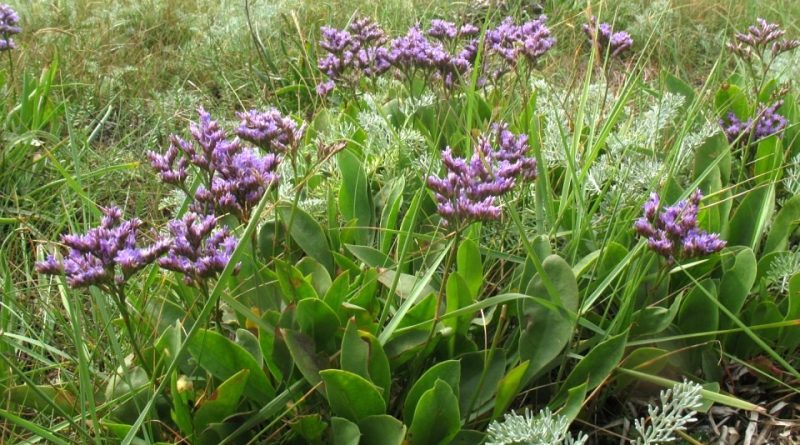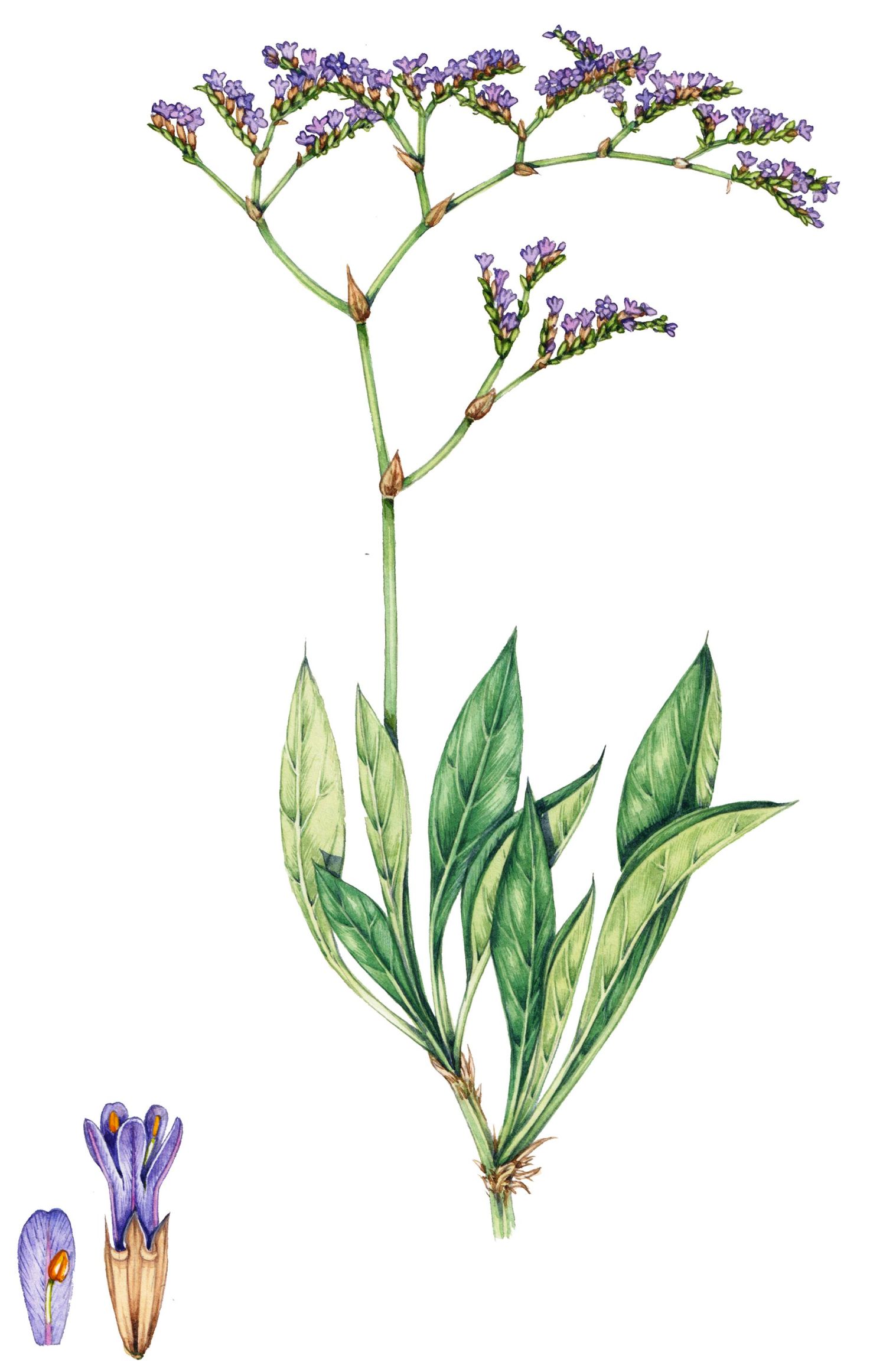Limonium narbonense
Limonium narbonense
The Sea Lavender (Limonium narbonense Mill.) is a herbaceous species belonging to the Plumbaginaceae family.
Systematics –
From a systematic point of view it belongs to:
Eukaryota Domain,
Kingdom Plantae,
Subarign Tracheobionta,
Spermatophyta superdivision,
Magnoliophyta Division,
Magnoliopsida class,
Subclass Caryophyllidae,
Order Plumbaginales,
Plumbaginaceae family,
Genus Limonium,
L. narbonense species.
The following terms are synonymous:
– Limonium angustifolium (Tausch) Degen;
– Limonium angustifolium (Tausch) Turrill;
– Limonium serotinum (Rchb.) Erben, nom. illegality .;
– Limonium serotinum (Rchb.) Pignatti;
– Limonium vulgare subsp. angustifolium (Tausch) P. Fourn .;
– Limonium vulgare subsp. serotinum (Rchb.) Gams;
– Statice angustifolia Tausch;
– Statice brunii Guss .;
– Statice limonium subsp. aggregate (Rouy) Rouy;
– Statice limonium subsp. angustifolia (Tausch) Rouy;
– Statice limonium subsp. serotin (Rchb.) Nyman;
– Statice serotin Rchb ..
Etymology –
The term Limonium comes from wild chard limonium, a plant mentioned by Pliny.
The specific Narbonense epithet refers to Narbonne (Narbonne), a city in southern France in the Languedoc region.
Geographic Distribution and Habitat –
The Sea Lavender is a species native to Mediterranean Europe, with an area centered on the Mediterranean coasts, but with extensions to the north and east but also present up to Great Britain, North Africa and North America.
In Italy it is common along the Adriatic coasts from Grado to Rimini and in Puglia, the western coasts from Livorno to the Neapolitan area, while in Sicily, Sardinia and other smaller islands it is rarer.
Its natural growth habitat is on clayey soils that are periodically flooded by the sea and in salty swamps.
Description –
Limonium narbonense is a perennial herbaceous plant of 30-70 cm in height.
It has short roots, provided with hairless, robust, cylindrical scapes, from spread or arched to erect-patent, densely branched in the upper part.
The leaves are arranged in a basal rosette, petiolate, from extremely eliptic to oblong-ovate, to lanceolate-spatulate, fleshy, penninervie, with lateral veins, 15-30 cm long, acute, with a whole sinuous flap, generally mucronate, also present during the anthesis.
It has a very ramified corymbose panicle inflorescence with pinkish-lilac flowers of 5.5, -6.5 mm in diameter, gathered in 2 floras in spikelets, 6 on 1 cm, arranged in dense unilateral spikes without leaves, which basically constitute the inflorescence, and wrapped in bracts (of acute or slightly sharp triangular shape, with a membranous margin, fleshy central part), bearing calyxes of about 5 mm with velvety tube on the ribs and triangular lobes. The bracts are found at the base of each spikelet and each ear and have no taxonomic importance, even if the external one covers a greater portion than the internal one. The corollas are gen. 1/4 – 1/3 longer than the glass.
It blooms from June to September.
The fruit is a minute achene (diclesio) of a brown-greenish color, normally protruding from the persistent calyx, of c. 4-4.4 x 1-1.2 mm; ripens in autumn.
The seeds are ellipsoid, compressed, about 3 x 1 mm with a slightly foveolate surface, of a dark brownish color.
Cultivation –
The Sea Lavender is a perennial plant that is harvested in nature for local use as a medicine and source of materials.
This plant grows well in light, dry soils and tolerates maritime exposure.
The plant can be propagated by seed which is sown in spring and then transplanted in the open field in late spring or early summer.
Propagation can be carried out by division, to be carried out in spring (even if it is very difficult) or by root cuttings in late autumn or winter.
It is a plant suitable for country gardens or to form spots of 5-7 specimens, in order to enhance the vaporous effect of flowering, after which it is good to cut the withered stems at the base.
To obtain excellent specimens, it is advisable to fertilize in spring with organic fertilizer such as compost or well-mature manure.
Customs and Traditions –
In some European countries this plant is considered as a kind of sea lavender or heather, such as in England or France.
The inflorescences of Limonio are of a beautiful pink-lilac color and are kept for a long time.
Unfortunately, the often indiscriminate collection of this plant, added to the rarefaction of habitats, to the works of safeguarding, reclamation of coasts and river mouths, has led the Emilia-Romagna region to include it among the protected species. (L. R. n. 2/77).
It is an excellent plant for bees and is also used in the medicinal field.
The roots are decongestant and purifying and are used in the treatment of consumption with bleeding.
Among other uses, it was used, especially in the past, to repel moths.
The root is a source of tannin.
Preparation Method –
Limonium narbonense is a plant that, among its various uses, is also used in the medicinal field.
The roots are mainly used but also the flowers that are decongestant and purifying.
Among other uses, it was used, especially in the past, to repel moths.
It is also used as an ornamental plant.
Guido Bissanti
Sources
– Acta Plantarum – Flora of the Italian Regions.
– Wikipedia, the free encyclopedia.
– Useful Tropical Plants Database.
– Conti F., Abbate G., Alessandrini A., Blasi C. (ed.), 2005. An annotated checklist of the Italian vascular flora, Palombi Editore.
– Pignatti S., 1982. Flora of Italy, Edagricole, Bologna.
– Treben M., 2000. Health from the Lord’s Pharmacy, Advice and experiences with medicinal herbs, Ennsthaler Editore.
Warning: Pharmaceutical applications and alimurgical uses are indicated for informational purposes only, they do not represent in any way a medical prescription; therefore no responsibility is taken for their use for curative, aesthetic or food purposes.


